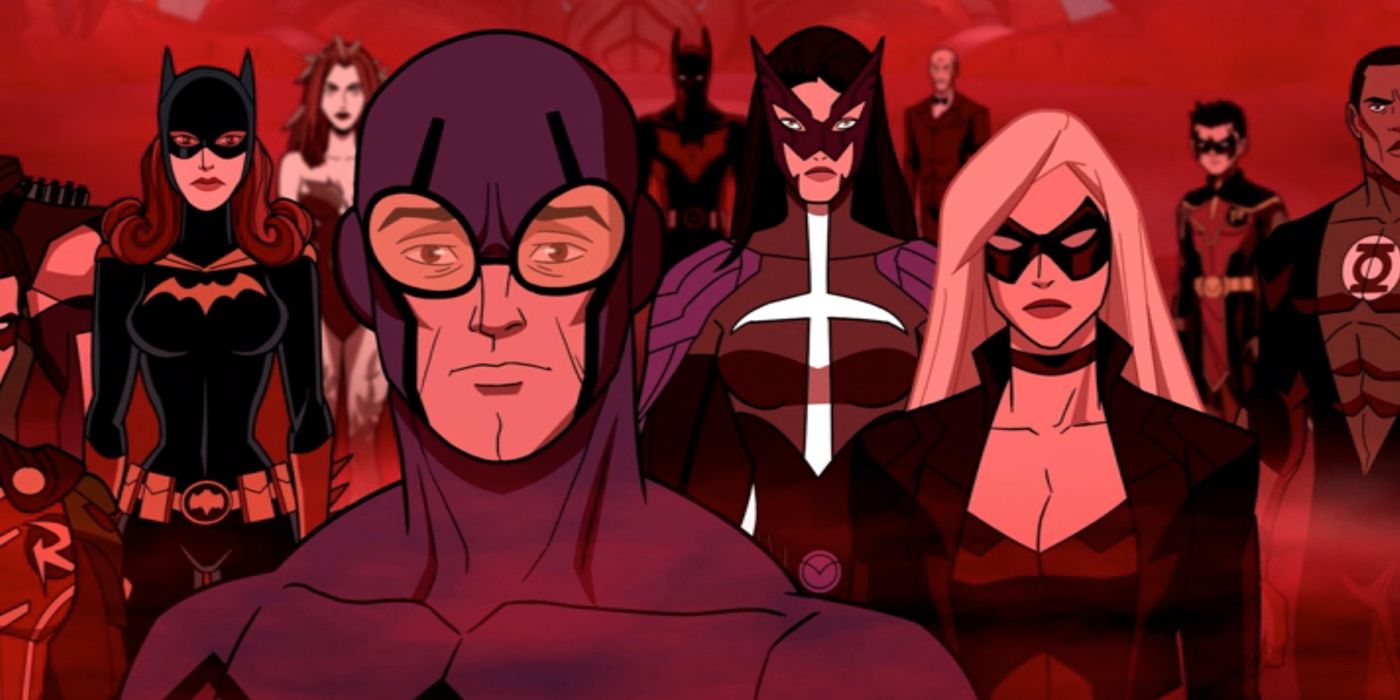[[{“value”:”
Quick Links
The second era of DC Animated Movies began with Superman: Man of Tomorrow and ended with Justice League: Crisis On Infinite Earths – Part Three. The movies, dubbed the “Tomorrowverse” by fans, shared a continuity and introduced new versions of DC Comics’ most famous characters. Yet, while previous shared continuities of animated films lasted for years, the Tomorrowverse completed its journey through the multiverse with 10 movies over four years. Why did it end so soon?
The classic DC Animated Universe ran from the early 1990s into the 2000s. Aside from a few standalone, “Elseworlds” films, the next series was the DC Animated Movie Universe, which ran from 2013 through 2020. The end of that story, Justice League Dark: Apokolips War, ended with Earth being decimated by Darkseid and the Flash was sent to the past to reboot history again. A few months later, Superman: Man of Tomorrow debuted the Tomorrowverse, but it came at a transitional time for Warner Bros. and DC adaptations. Not even a year after the first film, WB’s parent company, AT&T, entered the negotiations that would lead to Warner Bros. Discovery. Not long afterwards, James Gunn and Peter Safran were put in charge of DC storytelling, but their planned DC Universe isn’t why the Tomorrowverse came to an abrupt end.
DC Comics Shared Universes
Studio
Identifier
Number of Series & Films
Years Active
Filmation
Filmation Adventures
Five
1966-1970
Hanna Barbera
Super Friends
Seven
1973-1986
Warner Bros. Animation
DC Animated Universe
Nineteen
1992-2005, 2015-2019
Warner Bros. Animation
DC Animated Movie Universe
Eighteen
2013-2020
Warner Bros. Animation
Tomorrowverse
Thirteen
2020-2024
The Fix for DC’s Animated Movie Problem Is Surprisingly Simple
DC’s animated moves for home video will continue, but DC Studios should change the approach for future projects following Crisis on Infinite Earths.
Long before live-action comic book adaptations and shared continuity was in vogue, Filmation created DC’s first “cinematic universe” with a suite of series running from 1966-1970. This was followed up with Hanna Barbera’s classic Super Friends series. Their sister studio Ruby Spears tried it once again when they introduced Wonder Woman in the 1988 Superman animated series, though they never made it past a single season.
Eventually, Warner Bros. opened their own animation production house, and it led to what many consider to be the very best adaptation of DC Comics characters ever done.
Beginning with Batman: The Animated Series in 1992, the DC Animated Universe expanded beyond The Dark Knight to shows centered on Superman and the Justice League. Along with a series of films, the DCAU ran consistently until 2005. A handful of films were released in the late 2010s fitting into the same continuity. The only exception is Justice League: Gods and Monsters, as the canon status of that film is uncertain. While the live-action shared universes (whether on the big screen or The CW) didn’t find the universal praise the early Marvel Cinematic Universe did, the DCAU continues to be held up as the gold-standard for all-ages superhero storytelling.
In 2013, the first film in the DCAMU launched by adapting The New 52 iteration of DC Comics’ most well-known characters. These films proved to be about as controversial as the comics, though they endured for two years longer than the reboot did in the comics. In fact, the third Justice League: Crisis On Infinite Earths film confirmed the “Tomorrowverse” was, essentially, an extension of that story. While that creative decision may be relevant, the Tomorrowverse ended so quickly because of the changes coming at Warner Bros.
Changes at Warner Bros. Meant DC Animation Couldn’t Make Long-Term Plans
Justice League: Crisis on Infinite Earths Part 3 Revisits DC Animation’s Biggest Mistake
The Tomorrowverse’s adaptation of a classic DC story features an unlikely cameo that revisits one of the franchise’s darkest films.
The talks for Warner Bros. eventual merger with Discovery, Inc. officially began in 2021, but the writing was on the wall earlier than that. In 2019, after the failure of the Justice League theatrical film, AT&T began cutting budgets and even selling off pieces of the former Time Warner empire. Once the merger was in full-swing, everyone working for WB and DC knew big changes were coming. Still, the storytellers didn’t stop working, but they were limited in what they could do.
Despite the transition in corporate ownership, the Tomorrowverse survived the most difficult period at WB Discovery during that first post-merger year. The live-action Batgirl movie was shelved, along with many other projects, some of them fully complete. The executives at WB Discovery seemed far more concerned with cutting debt than producing films and television series, especially for iconic properties like the DC Universe, Scooby-Doo and the Looney Tunes.
Despite the perceived mismanagement of the studio, Tomorrowverse producers were given a slight budget increase to finish out the story. The Crisis On Infinite Earths adaptation was pitched as a five or six movie series, but ultimately whittled down to three. Executives “definitely had to enlarge the budget for us to be able to use all the voices [in] the Crisis movie. Normally, there’s a maximum of voice actors that you can use for any given DC Universe film. But the Crisis film…[needed] double or triple the amount,” producer Butch Lukic told CBR.
The Tomorrowverse Animated Films Were Always Limited to 10 Installments
Every DC Animated Series Since 2010, Ranked
DC has had many popular animated hits over its long history, and many of the most memorable came within the past decade-and-a-half.
The larger story arc that began with Superman: Man of Tomorrow was always meant to be just 10 feature films, along with a handful of shorts. This actually allowed Lukic and his team to “use the budgets from the other films” to effectively adapt Crisis in animation, specifically “pre-designing stuff in the first few films” that were brought back for the finale. Budget considerations are also why some familiar DC characters are seen in the film but not heard. Producers simply couldn’t afford to hire more actors to give them a voice.
In a separate interview with CBR’s sister site ScreenRant, Lukic and producer Jim Krieg explained Warner Bros. knew the Tomorrowverse would run for only 10 films. Once this arc was complete, WB wanted to bring in “a couple of producers [to] do another universe, which turned out to be” Gunn and Safran. In fact, the animated universe will be tied to the live-action one. The animated series Creature Commandos will be the first offering from the new DCU.
The Tomorrowverse Film Series
Title
Release Date
Type of Film
Adam Strange
May 5, 2020
Short
Superman: Man of Tomorrow
August 23, 2020
Feature
Justice Society: World War II
April 27, 2021
Feature
Kamandi: The Last Boy on Earth!
April 27, 2021
Short
Batman: The Long Halloween – Part One
June 22, 2021
Feature
Batman: The Long Halloween – Part Two
July 27, 2021
Feature
Blue Beetle
July 27, 2021
Short
Constantine: The House of Mystery
May 3, 2022
Short
Green Lantern: Beware My Power
July 26, 2022
Feature
Legion of Superheroes
February 7, 2023
Feature
Justice League: Warworld
July 25, 2023
Feature
Justice League: Crisis On Infinite Earths – Part One
January 9, 2024
Feature
Justice League: Crisis On Infinite Earths – Part Two
April 23, 2024
Feature
Justice League: Crisis On Infinite Earths – Part Three
July 16, 2024
Feature
What Can James Gunn’s DCU Learn From DC’s Anime Efforts?
James Gunn has to bring DC’s film back from the dead, but recent anime offerings can instill hope for fans and the filmmaker alike.
Superman: Man of Tomorrow was an excellent film and introduction to this new continuity. Subsequent releases, specifically Justice Society: World War II and Batman: The Long Halloween reinforced the potential the Tomorrowverse had to adapt beloved DC Comics stories into animation. The voice cast was inspired, and the Crisis films even brought back Mark Hamill and the late Kevin Conroy one final time.
However, the biggest problem with the Tomorrowverse as a whole lies with the stories the producers chose to tell. In the middle of the run, it felt like the films picked up in the timeline just before or after a more interesting story. Superman discovering he has a cousin, the formation of the Justice League and other significant events all happened off-screen. The stories didn’t really show the development of characters’ relationships, with most of that happening off-screen.
James Gunn’s universe didn’t end the Tomorrowverse, because it was always meant to be brief. Much like some of the other recent attempts to create a larger DC Comics shared continuity, there are a few bright spots among a sea of missed opportunities. The Tomorrowverse was an interesting take on the DC mythos, but it never really had a chance to shine as brightly as it could have.
The Tomorrowverse films are available to own on DVD, Blu-ray, digital and stream on Max.
“}]] The DC Animated Tomorrowverse ended with the release of Justice League: Crisis On Infinite Earths – Part Three, after only 10 films and four years. Read More

